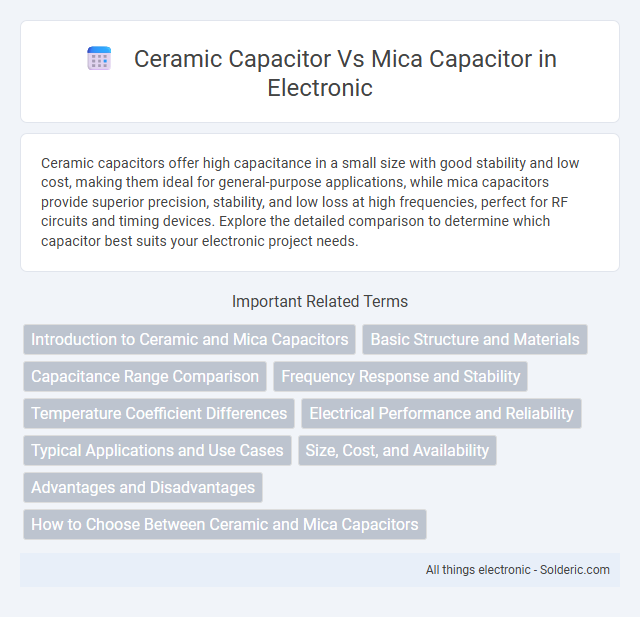Ceramic capacitors offer high capacitance in a small size with good stability and low cost, making them ideal for general-purpose applications, while mica capacitors provide superior precision, stability, and low loss at high frequencies, perfect for RF circuits and timing devices. Explore the detailed comparison to determine which capacitor best suits your electronic project needs.
Comparison Table
| Feature | Ceramic Capacitor | Mica Capacitor |
|---|---|---|
| Dielectric Material | Ceramic (barium titanate or other ceramic compounds) | Mica (natural or synthetic mica sheets) |
| Capacitance Range | 1 pF to 1 mF | 1 pF to 0.1 mF |
| Tolerance | +-5% to +-20% | +-1% to +-5% |
| Temperature Stability | Moderate to Good (depending on ceramic type) | Excellent (low temperature coefficient) |
| Voltage Rating | Up to 10 kV | Up to 100 kV |
| Dielectric Loss | Low to moderate | Very low |
| Applications | General purpose, decoupling, filtering | High precision RF circuits, oscillators |
| Size & Cost | Small, low cost | Larger, higher cost |
| Frequency Range | Up to GHz range | Up to GHz with low losses |
Introduction to Ceramic and Mica Capacitors
Ceramic capacitors utilize ceramic materials as the dielectric, offering high capacitance stability and low loss, ideal for general-purpose electronic circuits. Mica capacitors employ natural or synthetic mica dielectric, known for superior precision, temperature stability, and reliability in high-frequency applications. Both capacitor types serve distinct roles, with ceramic capacitors favored for cost-effective bulk capacitance and mica capacitors chosen for precision and stability in demanding environments.
Basic Structure and Materials
Ceramic capacitors consist of multiple layers of ceramic dielectric material sandwiched between metal electrodes, typically made from barium titanate or similar compounds, offering high permittivity and stability. Mica capacitors use natural mica sheets as the dielectric material, known for their excellent insulating properties, combined with metal foil or vapor-deposited silver electrodes to achieve high precision and low loss. The fundamental difference lies in the dielectric material, with ceramics providing higher capacitance density and mica ensuring superior stability and reliability under varying environmental conditions.
Capacitance Range Comparison
Ceramic capacitors typically offer a broad capacitance range from a few picofarads to several microfarads, making them versatile for various electronic applications. Mica capacitors, in contrast, generally provide lower capacitance values, usually up to a few hundred picofarads, but excel in stability and precision. Your choice depends on the required capacitance range and the importance of tolerance and temperature stability in your circuit design.
Frequency Response and Stability
Ceramic capacitors exhibit excellent high-frequency response due to low Equivalent Series Resistance (ESR) and inductance, making them ideal for RF applications, whereas mica capacitors provide superior frequency stability with minimal dielectric loss over a broad temperature range. Your choice depends on whether rapid signal handling or long-term oscillation precision is needed. Mica capacitors excel in applications requiring stable capacitance under varying environmental conditions, while ceramic capacitors are preferred for cost-effective high-frequency performance.
Temperature Coefficient Differences
Ceramic capacitors typically exhibit a wider range of temperature coefficients, often classified as Class 1 (NP0/C0G) with very stable capacitance over temperature, or Class 2 and 3 with higher, less predictable temperature coefficients. Mica capacitors provide highly stable and low temperature coefficients, generally around +-100 ppm/degC, making them ideal for precision applications requiring excellent temperature stability. The superior temperature coefficient stability of mica capacitors reduces capacitance drift and ensures reliable performance in critical circuits exposed to varying thermal conditions.
Electrical Performance and Reliability
Ceramic capacitors offer high dielectric stability and low equivalent series resistance (ESR), making them suitable for high-frequency applications but may exhibit capacitance variation with temperature and voltage. Mica capacitors provide exceptional electrical performance with ultra-low losses, high precision, and superior stability over temperature, ensuring reliable operation in demanding RF and precision circuits. Your choice depends on the required stability, operating frequency, and reliability standards, with mica capacitors preferred for critical, high-reliability applications.
Typical Applications and Use Cases
Ceramic capacitors are commonly used in high-frequency circuits, decoupling applications, and signal filtering due to their stability and low inductance, making them ideal for consumer electronics, power supplies, and RF circuits. Mica capacitors excel in precision timing circuits, RF transmitters, and oscillators where low loss, high Q factor, and temperature stability are critical, often found in aerospace and telecommunications equipment. Your choice between these capacitors depends on the circuit requirements for accuracy, frequency response, and environmental conditions.
Size, Cost, and Availability
Ceramic capacitors are generally smaller and more cost-effective than mica capacitors, making them ideal for compact and budget-sensitive applications. Mica capacitors, while larger and more expensive, offer superior stability and precision, often used in high-frequency and high-reliability circuits. Your choice depends on whether size and cost efficiency or performance and reliability are the primary requirements for your project.
Advantages and Disadvantages
Ceramic capacitors offer high capacitance values, excellent stability, and low cost, making them ideal for general-purpose applications, but they exhibit higher dielectric absorption and can be less stable at high frequencies. Mica capacitors provide superior precision, low losses, and excellent temperature stability, suitable for high-frequency and high-precision circuits, though they are typically more expensive and have lower capacitance values. The choice depends on balancing cost, stability, frequency response, and capacitance needs within a specific electronic design.
How to Choose Between Ceramic and Mica Capacitors
Choosing between ceramic and mica capacitors depends on your application's frequency stability and temperature tolerance needs. Ceramic capacitors offer high capacitance values in small sizes, suitable for decoupling and filtering, while mica capacitors provide superior precision, low loss, and excellent stability for RF circuits and high-frequency applications. Your decision should factor in capacitance range, dielectric properties, and operating environment to ensure optimal performance.
Ceramic capacitor vs mica capacitor Infographic

 solderic.com
solderic.com